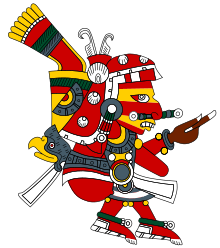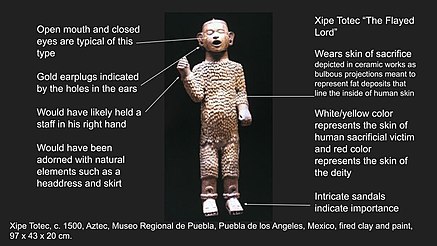
Back كسيبي توتيك Arabic Xipe-Totec Breton Xipe-Totec Catalan Xipe Totec Czech Xipe Totec German Σίπε Τότεκ Greek Xipe Tótec Spanish چیپی توتک Persian Xipe Totec Finnish Xipe Totec French
| Xipe-Totec | |
|---|---|
| Member of the Tezcatlipocas | |
 Xipe Totec as depicted in the Codex Borgia | |
| Other names | Red Tezcatlipoca, Camaxtli, Camaxtle, Xipe |
| Abode | • Ilhuicatl-Teteocan[2] (Twelfth Heaven) • the East[2] |
| Symbol | Quail |
| Gender | Male |
| Region | Mesoamerica |
| Ethnic group | Aztec (Nahua) |
| Festivals | Tlacaxipehualiztli |
| Genealogy | |
| Parents | Ometecuhtli and Omecihuatl (Codex Zumarraga)[2] |
| Siblings | Quetzalcoatl, Tezcatlipoca, Huitzilopochtli (Codex Zumarraga)[2] |
| Children | None |

In Aztec mythology, Xipe Totec (/ˈʃiːpə ˈtoʊtɛk/; Classical Nahuatl: Xīpe Totēc [ˈʃiːpe ˈtoteːk(ʷ)]) or Xipetotec[3] ("Our Lord the Flayed One")[4] was a life-death-rebirth deity, god of agriculture, vegetation, the east, spring, goldsmiths, silversmiths, liberation, deadly warfare, the seasons,[5] and the earth.[6] The female equivalent of Xipe Totec was the goddess Xilonen-Chicomecoatl.[7]
Xipe Totec connected agricultural renewal with warfare.[8] He flayed himself to give food to humanity, symbolic of the way maize seeds lose their outer layer before germination and of snakes shedding their skin. He is often depicted as being red beneath the flayed skin he wears, likely referencing his own flayed nature. Xipe Totec was believed by the Aztecs to be the god that invented war.[9] His insignia included the pointed cap and rattle staff, which was the war attire for the Mexica emperor.[10] He had a temple called Yopico within the Great Temple of Tenochtitlan.[11] Xipe Totec is associated with pimples, inflammation and eye diseases,[12][13] and possibly plague.[14] Xipe Totec has a strong relation to diseases such as smallpox, blisters and eye sickness[15] and if someone suffered from these diseases offerings were made to him.[16]
This deity is of uncertain origin. Xipe Totec was widely worshipped in central Mexico at the time of the Spanish Conquest,[11] and was known throughout most of Mesoamerica.[17] Representations of the god have been found as far away as Tazumal in El Salvador. The worship of Xipe Totec was common along the Gulf Coast during the Early Postclassic. The deity probably became an important Aztec god as a result of the Aztec conquest of the Gulf Coast in the middle of the fifteenth century.[11]
In January 2019, Mexican archaeologists from the National Institute of Anthropology and History confirmed that they had discovered the first known surviving temple dedicated to Xipe Totec in the state of Puebla.[18] The temple was found while examining ruins of the Popoluca peoples indigenous to Mexico. The Popolucas built the temple in an area called Ndachjian-Tehuacan between AD 1000 and 1260 prior to Aztec invasion of the area.[19]
- ^ "Xipe Totec | Aztec deity | Britannica". www.britannica.com. Retrieved 2023-06-20.
- ^ a b c d e Cecilio A. Robelo (1905). Diccionario de Mitología Nahoa (in Spanish). Editorial Porrúa. pp. 768, 769, 770. ISBN 970-07-3149-9.
- ^ Robelo 1905, p. 768.
- ^ Marshall Saville, 1929, p. 155.
- ^ Fernández 1992, 1996, pp.60-63. Matos Moctezuma 1988, p.181. Matos Moctezuma & Solis Olguín 2002, pp.54-5. Neumann 1976, pp.252.
- ^ Ceram, C. W. (1967). Gods, Graves, and Scholars: The Story of Archaeology. Translated by Garside, E. B.; Wilkins, Sophie (2nd ed.). New York: Alfred A. Knopf. p. 411.
- ^ Matos Moctezuma & Solis Olguín 2002, p.426.
- ^ Evans and Webster 2001, p. 107.
- ^ Matos Moctezuma & Solis Olguín 2002, p.423.
- ^ Toby Evans & David Webster, 2001, p.107
- ^ a b c Miller & Taube 1993, 2003, p.188.
- ^ Susan Toby Evans; David L. Webster (11 September 2013). Archaeology of Ancient Mexico and Central America: An Encyclopedia. Taylor & Francis. p. 218. ISBN 978-1-136-80185-3.
- ^ worldhistory.org
- ^ Bob Curran; Ian Daniels (2007). Walking with the Green Man: Father of the Forest, Spirit of Nature. Career Press. p. 148. ISBN 978-1-56414-931-2.[permanent dead link]
- ^ Cite error: The named reference
Fernández 1992, 1996, p.62was invoked but never defined (see the help page). - ^ Citing Bernardino de Sahagún:O., Anderson, Arthur J.; E., Dibble, Charles (1970-01-01). General history of the things of New Spain : Book I, the Gods. School of American Research. ISBN 9780874800005. OCLC 877854386.
{{cite book}}: CS1 maint: multiple names: authors list (link) - ^ Fernández 1992, 1996, p.60.
- ^ Wade, Lizzie, Archaeologists have found a temple to the ‘Flayed Lord’ in Mexico, Science, January 4, 2019
- ^ "Mexican experts discover first temple of god depicted as skinned human corpse". TheGuardian.com. 3 January 2019.
© MMXXIII Rich X Search. We shall prevail. All rights reserved. Rich X Search